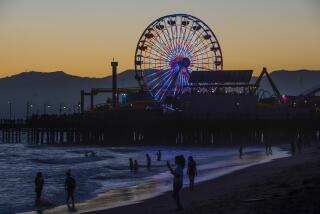L.A. start-up’s plasma lights help turn film and TV shoots green

Rob Rutherford looked up from his workbench, order receipts and debris from Hive Lighting’s products strewn around his laptop.
“The bulbs shipped,” he said to business partner Jon Miller. Both grinned.
More bulbs meant more business: new film, TV and commercial sets to be illuminated by Hive’s energy-saving plasma lights, which represent a step forward in energy-efficient production.
PHOTOS: Hollywood backlot moments
Hollywood has embraced the cause of environmental sensitivity. In recent years, the Producers Guild of America and major studios have launched green initiatives that focus on efforts such as recycling trash and diverting props and sets away from landfills.
But it’s been more difficult to change the way films are made — with their trucks and generators — so that productions use less energy and curb pollution.
Since incorporating Hive in February 2011, 30-year-olds Rutherford, Miller and their partner, Jaime Emmanuelli, 46, have built a brand around a relative newcomer in production technology.
Plasma lights, more often used in street lamps and medical imaging, breeze past the color-quality problems in LED lights. They last as much as 30 times longer than conventional hydrargyrum medium-arc iodide lights — a perk on months-long film shoots with 18-hour days.
Plasma lights can reduce on-set energy usage by 50% and power costs by about 40%, Miller said. And perhaps the most crucial advantage in an industry driven by aesthetics, plasma lights won’t flicker, and they cover the full color spectrum while conventional lights lack certain shades.
Jay Hunter, director of photography on Joss Whedon’s “Much Ado About Nothing,” used Hive’s lights when the indie film’s shoestring budget required the crew to shoot without a generator.
ON LOCATION: Where the cameras roll
“They don’t replace the lights that are out there completely,” Hunter said. “The sun is the best color-rendering index possible, but the plasma lights approach that level of perfection.”
When it comes to energy-efficient production, “lighting is one of the last frontiers,” said Kris Barberg, executive director of EcoSet Consulting. Her firm advises clients including Honda, Microsoft and Target on how to make commercial shoots as green as possible.
Barberg said she recommends Hive, but “a lot of people just don’t care to be in the conversation of responsible best practices on film productions. They just want to get the shot.”
Hunter said his decision to use Hive’s lights was less about saving the planet than it was playing with new technology while saving money.
“No one’s going to give me an award or hire me in another job because I saved the production 1,000 gallons of fuel in the generator and didn’t use as many light bulbs,” he said.
Shannon Bart, who founded EcoSet before leaving to become sustainable production manager at NBCUniversal, said industry professionals are ready to embrace advancements in efficient technology.
“It doesn’t happen overnight, and new technology isn’t always cheaper, but [cost] hasn’t always been a complete stopping point,” she said.
Bart said spreading sustainability “takes everybody involved — including studios and small vendors like Hive — coming up with great solutions.”
Amanda Scarano Carter, West Coast chair of the Producers Guild of America’s green initiative, said much of the responsibility in standardizing energy efficiency lies with major entertainment companies.
But, she said, that leaves out a substantial portion of entertainment produced by independent filmmakers with far fewer resources. “It becomes problematic when it comes down to just interested individuals who don’t have money backing them.”
Despite Hive’s initial success, cinematographers haven’t been beating down the door of its downtown garage work space, nestled behind the Los Angeles Cleantech Incubator, which gave the company its start.
“The No. 1 question we still get is ‘What the heck is that?’” Miller said. “And usually not that politely phrased.”
PHOTOS: Celebrities by The Times
Miller, Rutherford and Emmanuelli declined to divulge financial specifics other than to say that revenue so far this year has been 10 times higher than in all of 2012. Besides the three partners, the company has two full-time employees and about a dozen part-time workers.
They’re exporting to Brazil, Australia, France and Germany. Their lights lit the “Much Ado” red carpet at this year’s SXSW festival in Austin, Texas, as well as the sets of CBS hits “The Mentalist” and “CSI: Crime Scene Investigation.” On Monday, the Hive partners learned they would be lighting next month’s swimming competition at the International Paralympic Committee’s World Championships in Montreal.
To supply these high-profile projects and events, Hive tries to keep operations homegrown.
Hive gets its bulbs from Luxim Corp. in Sunnyvale, Calif., and Topanga Technologies in Canoga Park. Sheet metal and paint jobs are done in North Hollywood. Glass covering the bulbs comes from Sylmar, where another company supplies the rings surrounding the lenses.
The one element that comes from outside the U.S. is the electronics board in each unit, parts of which ship from China. A third Sylmar company, Mogul Manufacturing, puts it all together based on Hive’s design.
“The more product we have, the more demand it creates. And the more opportunities we have,” Miller said, “to show everyone what we can do.”
Twitter: @c_s_green
More to Read
From the Oscars to the Emmys.
Get the Envelope newsletter for exclusive awards season coverage, behind-the-scenes stories from the Envelope podcast and columnist Glenn Whipp’s must-read analysis.
You may occasionally receive promotional content from the Los Angeles Times.






